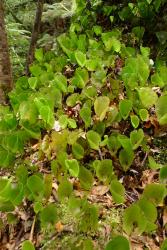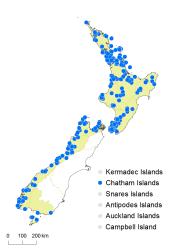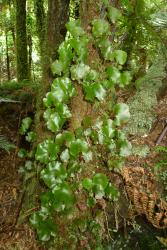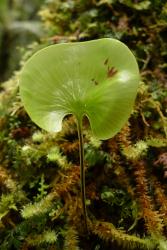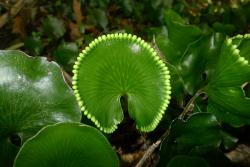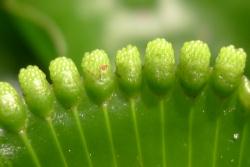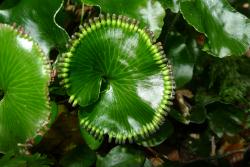- ≡ Trichomanes reniforme G.Forst., Fl. Ins. Austr. 84 (1786)
- ≡ Cardiomanes reniforme (G.Forst.) C.Presl, Hymenophyllaceae 13 (1843)
Terrestrial, rupestral or low epiphytic ferns. Rhizomes long-creeping, 0.5–1 mm diameter; rhizome hairs red-brown, dense at bases of stipes, scattered elsewhere, up to 2 mm long. Fronds 40–280 mm long. Stipes 20–240 mm long, reddish brown throughout, narrowly winged distally for more than half their length, brittle, glabrous or with a few short scattered hairs. Laminae undivided, reniform or almost orbicular, fertile 17–65 mm long, 25–105 mm wide, sterile sometimes a little larger and more irregular in outline, shiny green, herbaceous, two or more cells thick, glabrous; margins entire, thickened to form a distinct border. Rachises absent. Primary pinnae absent. Ultimate segments absent. Sori borne around lamina margin, many on each lamina, crowded, partially to deeply immersed in lamina; indusia urceolate, 1–2 mm long, not widened at mouth, margins entire; receptacles exserted up to 4 mm.
Hymenophyllum nephrophyllum is immediately recognised by its undivided, kidney-shaped lamina bearing numerous sori around the margin. The urceolate indusia and slightly exserted receptacles are unusual in Hymenophyllum, and account for the fact that the species has previously been included in Trichomanes (Allan 1961; Brownsey et al. 1985; Brownsey & Smith-Dodsworth 2000) or the segregate genus Cardiomanes (Crookes 1963). It is now treated in the monotypic subgenus Cardiomanes (Ebihara et al. 2006).
North Island: Northland, Auckland, Volcanic Plateau, Gisborne, Taranaki, Southern North Island.
South Island: Western Nelson, Sounds-Nelson, Westland, Southland, Fiordland.
Chatham Islands, Stewart Island.
Altitudinal range: 10–780 m.
Hymenophyllum nephrophyllum occurs throughout the North Island in lowland and montane forest, but is absent from much of the east coast. It ranges from sea level to about 750 m near Lake Waikaremoana, on Mt Taranaki and in the Tararua Ranges, reaching 780 m in the western Raukūmara district. In the South Island it extends from the Marlborough Sounds through north-west Nelson, Westland and Fiordland to southern Southland. It grows from sea level up to 600 m in the Nelson Lakes District.
Hymenophyllum nephrophyllum forms extensive mats on the forest floor, on fallen trunks, on banks and rocks, on lava fields, in moss forest, at the base of tree trunks and as a low epiphyte in kauri, podocarp, broadleaved and beech forest, and in old kānuka scrub.
n = 36 (Brownlie 1958).
Hymenophyllum nephrophyllum is a nomen novum for Cardiomanes reniforme, required because the name Hymenophyllum reniforme is pre-occupied (Ebihara et al. 2010).
Hymenophyllum nephrophyllum, together with H. dilatatum and H. scabrum, is unusual in the genus in having a frond that is more than one cell thick. Holloway (1923) showed that sporelings had a lamina only one cell thick and that the multi-layered condition developed with maturity.



